What Is Garbage Disposal Equipment?

Garbage disposal equipment refers to machines designed to reduce and deodorize the volume of food waste produced by both businesses and households.
With food waste constituting approximately 30% of general waste, these machines significantly decrease waste weight and volume by removing moisture, simplifying waste management and disposal processes.
Key types of food waste disposal systems include heating, bio, and carbonization methods, each employing different techniques to process and reduce food waste effectively.
Applications of Garbage Disposal Equipment
Garbage disposal systems are instrumental in managing food waste from various sources, including food production facilities, restaurants, and households, facilitating waste reduction and recycling efforts.
Processed waste can be repurposed as feed or fertilizer, with bio-based products being particularly suitable for such reuse. Moreover, household garbage disposals may receive subsidies from local authorities to encourage waste reduction.
Principle of Garbage Disposal Equipment
Diverse garbage disposal technologies—such as heated, bio-based, pulverizing, drying, carbonizing, and hybrid systems—employ unique mechanisms to process food waste.
1. Heating Type
This method involves heating food waste to evaporate moisture, significantly reducing its volume. Exhaust gases are treated to eliminate odors.
2. Bio-Type
Food waste is mixed with a base material and decomposed by bio-bacteria through aerobic digestion, transforming waste into compost within 4 to 20 hours.
3. Pulverizing Type
Installed under the kitchen sink, this device grinds food waste with water, allowing for easy disposal directly through the drainage system.
4. Drying Type
Food waste is dried using hot air, effectively reducing its moisture content and volume.
5. Carbonizing Type
This process steams and then carbonizes food waste, turning it into charcoal, further reducing its volume.
6. Hybrid Type
A combination of bio and drying methods, this system rapidly converts food waste into compost using a special treatment agent and warm air.
How to Select Garbage Disposal Equipment
Choosing the right garbage disposal system requires understanding the advantages and disadvantages of each type, considering factors such as operational costs, processing capabilities, and end-product usability.
1. Heating Type
Offers a straightforward process without the need for additional materials, though operational costs can be high due to energy consumption.
2. Bio-Type
Requires a base material but operates at lower temperatures and produces compost, offering an eco-friendly disposal solution.
3. Pulverizing Type
Ideal for direct kitchen waste management, but may be subject to installation constraints and noise considerations.
4. Drying Type
Reduces volume by drying, suitable for composting, albeit with lower volume reduction efficiency and higher energy costs.
5. Carbonizing Type
Provides a high volume reduction by transforming waste into charcoal, useful as a soil conditioner or fuel, but with higher energy requirements.
6. Hybrid Type
Less energy-intensive than drying alone, this method requires a treatment agent for effective waste conversion.